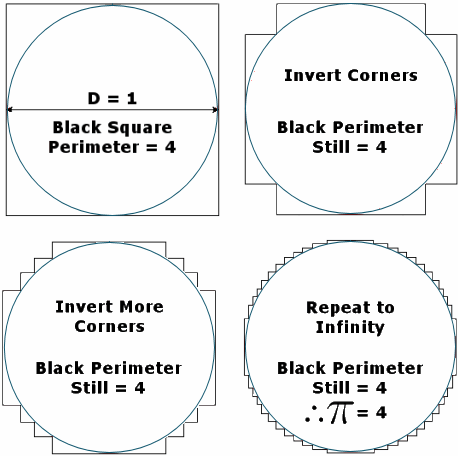9161
Flat Earth Theory / Re: Polaris proves the earth is round.
« on: February 18, 2016, 04:10:21 AM »... so the 'real' circumference in nature will be longer than the perfect circle, and sometimes much longer than a perfect circle, because of all the imperfections made by nature, right? But then 'pi' would never be a constant (e.g. = 4) - it would just be bigger than 3,1415.
The most perfect circle possible in a quantized universe would have a pi of 4. Most other circles may have slightly different values for pi, as they are less perfect, but that is mostly irrelevant to the discussion since the continuous universe of the Ancient Greeks also ignores imperfect circles. Any opposing model to the standard ancient one would assume the most perfect circle possible as well when coming up with a value for pi.
Quote from: brainsandgravy
I'm sorry, but this is just lame. We're talking about angles here, not "string theory ". Angles, like distances, are simply a way to quantify and/or describe the relationship physical objects have with one another in 3D space.
You say, "Samuel Birley Rowbotham teaches us in Earth Not a Globe that we must adopt our concept of perspective from real world experience and observations". It's terrific that you have such faith in the authority of your teacher, but he apparently has never really done much observing. You would do better to ask an architect, a navigator, a surveyor, or a cartographer, people who successfully use geometry everyday in real world observations. Applied mathematics like trigonometry were derived from pure observation and have been tried and tested for literally thousands of years. Trigonometry is not a theory. It works because it's true. Trigonometric relationships in the physical world are as certain as 2+2=4. They are as certain as any physical law. So if your flat earth sun does not obey physical laws then it cannot be physical and so you need to stop pretending that Flat Earth Theory is not a religion, because that's exactly what you are saying.
Why are you trying to use unverified ancient geometry/trigonometry as a proof of anything?
The Ancient Greeks did not verify that circles actually exist, and they did not verify that perspective lines actually stretch into infinity as they theorized.
Exactly. Zetetics claim to hold observation over theory, but then this nonsense about plancks, and PI = 4? Take a look around your home (AKA "conduct an observation"). Find an object that the rest of us would call 'round' and look at it. Does it appear to be round? If so, then the same philosophy that makes you say "The world LOOKS flat, I guess it must BE flat" should also lead you to the conclusion "This object LOOKS like a circle, I guess it must BE a circle". Wrap a string around the can, measure its length. "The strings MEASURES as if it were about 3.14 times the diameter, I guess it must BE 3.14 times the diameter." Repeat for other round objects. "Every round I object I MEASURE has a perimeter of 3.14 times its diameter, I guess ALL round objects exhibit that relationship"
When I pick up a can it looks like an object. It looks like a shape of some sort. I can safely say that it is an object. Assigning words like "circle" or "cylinder" to that shape brings me into the continuous universe of the Ancient Greeks, which we are increasingly coming to find were full of baloney, and whose science can be disproven by a simple act of walking through a door.




